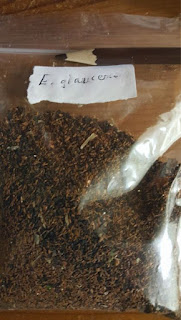Eucalyptus seed.
There are over 600 species of Eucalyptus. Many montane species or ones from Tasmania can grow well in The United Kingdom. Any generalisations I make about Eucalypts are often made from my own experience of a limited number of species.
The fruits of Eucalypts, called gumnuts, are small woody capsules. They vary in size from that of a small pea to that of a large pea. They ripen at least a year after flowering, so flowers and fruits can be found on the same branch. In the photograph they are the small black dots along some of the bare twigs. Eucalypts give up on leaves and branches that are not photosynthesising well comparatively quickly. If the base is shaded they grow tall and straight with clear trunks. The photograph is of a branch above 20feet of clear stem.
All gumnuts are fairly similar. The capsules being closed by usually 3 or 4 valves which open as the fruit dries. The shape of the capsules and the valves is a useful indicator of species as many eucalypts are similar and they do hybridise.
 |
| Some different gumnuts. The 2 black spots above the gunnii and the glaucescens are seeds. The brown speckling around the gunnii is chaff a padding from inside the capsules. |
The ideal shape for a eucalypt for fuel logs is tall and thin. This means that seed has to be collected from felled trees or branches cut with a pole saw. I try to collect small branches that have full size green gumnuts and place them in large clear plastic bags. The idea being the seeds can still mature if they are not and the will slowly dry out.
When the valves start to open I strip the gumnuts off the branches and put them into a small plastic bag to finish drying out and releasing their seed.
The bags get shaken so the seeds and chaff, an inert filler, can fall to the bottom. It is then a mater of separating off the gumnuts. The seeds are tiny and are the black specks. Kept dry they can remain viable for years. The bag probably contains a thousand seeds. The seeds are sold by weight and include some chaff, which is very light.
The bags get shaken so the seeds and chaff, an inert filler, can fall to the bottom. It is then a mater of separating off the gumnuts. The seeds are tiny and are the black specks. Kept dry they can remain viable for years. The bag probably contains a thousand seeds. The seeds are sold by weight and include some chaff, which is very light.







